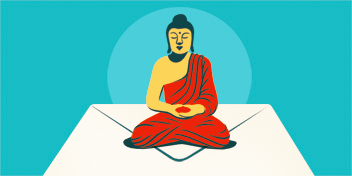A few weeks before quarantine arrived, my Buddhist friend remarked, jokingly, that it would be like a three-week silent meditation retreat. Sadly, that was late February —back when three weeks of lockdown seemed like an impossibly long time. We were stocking up on beans and Tylenol, but we didn’t really believe life as we knew it would come to a complete halt—certainly not for months. But it did, and with it came a familiar surge of anxiety.
I’ve found meditating—particularly the focused type done on retreats—a welcome relief from stressors in the past. If you subscribe to any meditation-centric newsletters or social media accounts, you may have seen resources or suggestions for creating your own at-home silent meditation retreat. You may have rolled your eyes, kept scrolling, or perhaps sat up from your couch-wide sprawl. Or you may have done a little of each. While an at-home retreat doesn’t feel as instinctively appealing as one in-person, maybe there’s something to the idea.
I attended a weeklong silent meditation retreat at Spirit Rock Meditation Center in Marin County, California, in October. In many ways, it prepared me for this time of quarantine—there wasn’t that much to do, I couldn’t talk to people, and I ate a lot of raisins. Still, I’d elected to go on the retreat, I knew when it would be over, and we weren’t in a pandemic—three factors that significantly affect the tenor and quality of self-isolation, at least for me.
Even so, I believed I could find some semblance of peace in quarantine, and I decided to attend a meditation retreat within my own apartment. I visited the site of one of my favorite teachers, Jack Kornfield, and clicked on one of his self-guided half-day meditation retreats: “Finding Freedom Wherever You Are.”
On the one hand, meditation is an activity that’s conducive to self-guidance. It’s solitary, and I meditate on my own every morning anyway. On the other, I found the community at the Spirit Rock retreat deeply helpful. Without what felt like social pressure to partake in the experience with my peers (although, of course, no one was silently pressuring me to do anything), I wondered if I’d even show up for the meditations. That’s why I chose to start with half a day’s worth of meditating on my own—I didn’t want to overextend my willpower.
Kornfield recommends creating a schedule for yourself based on his suggestion. I set aside a Saturday morning (I mean, does day of the week matter anymore?) and timed out the meditations, alternating between sitting, walking, yoga, and occasional snacking.
This is the schedule I laid out for myself. Kornfield recommends starting at 6:30 am. I took a bit of creative liberty and started at 9:00 am, for a variety of reasons, namely that I woke up at 8:40. He also recommends alternating between sitting and walking, so I did:
9:00-9:30: Sitting
9:30-10:00: Walking
10:00-10:30: Sitting
10:30-11:00: Mindful movement/yoga
11:00-11:30: Sitting
11:30-12:00: Lunch and writing
12:00-12:45: Sitting
I realized immediately how important it was for me to prepare my room for the retreat. Kornfield recommends setting up a “container of stillness.” This means figuring out where to meditate and telling the people in your life not to interrupt you. I live with my sister, and I made sure to tell her that I was going on retreat. Unfortunately, I informed her of this while I was taking a bathroom break in the middle of the retreat, so it wasn’t exactly “silent,” but it was close.
Some meditation halls boast a variety of delightful cushions, something my apartment sorely lacks. Instead, I made do with my own meditation stool—I actually bought it to be a footstool for watching TV, but I got the cheapest one on Amazon without checking the size, and it turned out to be too short to do anything but meditate on it. I threw in a rolled-up towel and a pair of slippers, and voilà!
When I meditate at home, I like to turn a space heater right in my face to convince myself I’m in an infrared sauna—this is probably bad for my skin, but it’s toasty and pleasant. After 15 minutes with the space heater, though, I turned it off. It was distracting me from staying mindful. (I was sweating; it was no longer pleasant.) There’s also a mirror in my room. Trying to meditate in front of a mirror made immediately clear why meditation halls don’t have them—every time I opened my eyes, whoops, there I was! I faced away from the mirror.
Kornfield also recommends setting an intention—mine was to “stay.” Even if I got distracted or wanted to do something else I told myself I wouldn’t. I’d stay. And I did, so I think intention-setting helped. Also, the fact that we’re under quarantine and can’t leave our apartments helped. I had to stay—there’s nowhere else to go.
My biggest struggle was keeping myself from my technology. I used my phone to time the meditations, but I intended to leave it on airplane mode all day. Handing a technology-addicted woman a phone on airplane mode and telling her not to use it is like giving a kid candy and telling him to read Moby Dick instead of eating the chocolate bar. Taking charge of my own phone was not nearly as effective as having it locked away from me on other retreats I’ve attended. For example, the airplane mode didn’t stop me from taking it to the bathroom with me as a force of habit. Still, I didn’t check Twitter for six hours—quite an accomplishment.
I adapted to the walking and yoga more smoothly than sitting. My stool wasn’t comfortable for long sits, but pacing back and forth in my tiny room was helpful. It turns out that I was much more able to engage with the sensation of my feet hitting the ground than I was at a meditation center, since I was already so familiar with my surroundings. I was less distracted, and could actually stay within my body instead of speculating about roaming geese (Spirit Rock is beautiful and known for its natural fauna). Same with the yoga—I had a much deeper awareness of my physical sensations, since paying attention to my breath was preferable to looking under my bed. It’s not that clean under there, FYI.
I learned a lot on the at-home retreat. For example, I noticed that my rug was far dirtier than I’d initially believed. I guess I don’t have time to vacuum it, probably because I’m so busy meditating. There was also the issue of my sister’s cat. I learned she did not, as I’d always believed, sleep all day. Indeed, the moment I started meditating, she leapt into my lap. Her litter box is in my room, so I couldn’t kick her out altogether, and I had to simply accept her. That’s OK—that’s what meditating is all about. Noticing and accepting the feline sitting on top of you.
At home, I was not at all self-conscious. Any time I’ve meditated in group settings, I’ve had a deep fear that others knew when my mind was drifting—when I was not just noticing thoughts arise but fully engaging with them. When I was daydreaming about Timothée Chalamet instead of turning inward. Of course, no one was actually judging me, but that perception altered the experience. On my own, fortunately, I was free from that anxiety. Timothée came and went, and I didn’t fear judgment.
Overall, I found the at-home retreat to be a very positive experience. We don’t always have perfectly idyllic circumstances in which to meditate, and sometimes, we must adjust to the world around us. The retreat filled me with a sense of calm I hadn’t been able to settle into since the coronavirus crisis began. Much like I cannot control this pandemic, I cannot control the cat sitting on my lap. And I felt just slightly more aware of that after my half-day of meditation in the confines of my home.
Thank you for subscribing to Tricycle! As a nonprofit, we depend on readers like you to keep Buddhist teachings and practices widely available.

